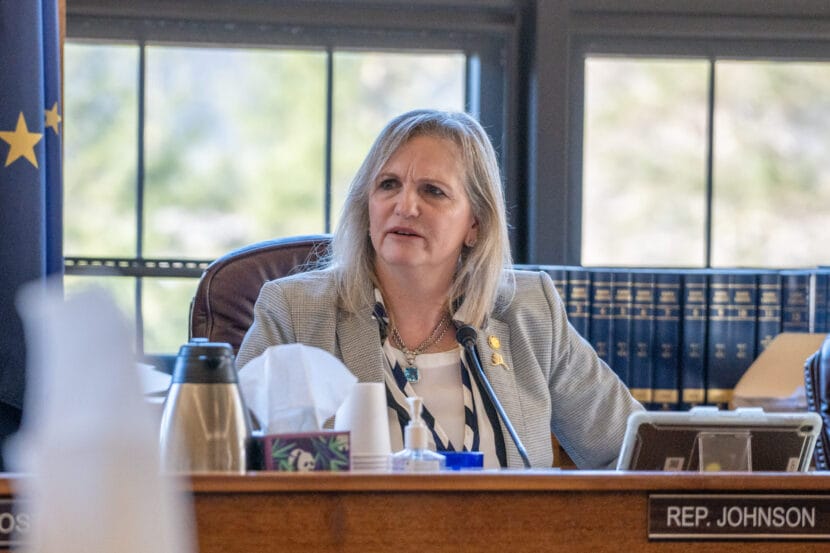The House Finance Committee is working through its latest draft of the state budget, and lawmakers are clashing on how much to give every Alaskan in their Permanent Fund dividend.
House Finance Committee co-chair DeLena Johnson, R-Palmer, said it should be about $2,300. That’s the amount in the House’s latest draft of the state’s operating budget and includes both a PFD and an energy relief check meant to offset high costs.
“We’ve tried in our office to thread a very fine line of getting the highest PFD that we can,” while also funding state services in a balanced budget, Johnson said.
But not everyone agrees. The PFD is, after all, one of the most hotly-debated issues in the Legislature every year — and it’s not necessarily a party-line issue.
Another House Finance Committee co-chair, Rep. Neal Foster, D-Nome, said the PFD should be the amount determined by a formula in state law. This year, it’d be about $3,500. He offered the proposal as a budget amendment at Wednesday’s House Finance Committee meeting.
“I know that my constituents back home, you know, they really do need you know, this PFD,” he said Thursday, as debate on the measure continued. “If we reduce the PFD, it is a regressive tax on lower- and middle-income folks, on families across Alaska, and I don’t want to go there.”
Foster is a member of the Republican-led House majority caucus, and his desire for a formula-driven PFD is shared by Gov. Mike Dunleavy, and many of Foster’s fellow caucus members. But not all.
“In order to pay a statutory dividend, this state either has to reduce its expenditures on government or tax people,” said Will Stapp, R-Fairbanks. “Those are your two options. You have no other options.”
Stapp objected to the $801 million cost of boosting the dividend to roughly $3,500. To make his point, he outlined a series of cuts that would free up $801 million: closing all of the state’s prisons and courts and shutting down the Department of Public Safety, among other things.
“I believe that the size and scope of our government can absolutely be reduced,” he said. “I don’t believe you can cut a billion dollars out of it. I don’t believe you can cut $801 million out of it, because you would have catastrophic consequences.”
Stapp was joined in opposition by members of the House’s mostly Democratic and independent minority caucus.
“We’ve heard over and over again that the statutory PFD, although it would be nice to receive, is in no way sustainable for future generations,” Rep. Dan Ortiz, I-Ketchikan, said.
Foster’s proposal would have drawn the $801 million necessary for the PFD boost from a super-sized withdrawal from the spendable portion of the Permanent Fund, the earnings reserve account. That account is the state’s biggest source of general-purpose money. The state draws down a consistent portion of the fund’s value — currently 5% — to fund schools, prisons and other state services. The state has never gone above that maximum in state law, but Foster’s proposal would have required pushing this year’s draw north of that figure, to 6.1%, and legislative budget analysts said that would be risky.
The $3,500 PFD proposal failed 3-8 in the Finance Committee on Thursday in two separate votes, including one that would have drawn the $800 million from the state’s constitutional budget reserve account rather than the earnings reserve. Supporters vowed to try again once the budget comes to the House floor.
But over in the Senate, Finance Committee co-chair Sen. Bert Stedman, R-Sitka, said even the smaller $2,300 dividend faces long odds.
“It’s highly unlikely that this size of dividend will materialize in the final budget, because there’s such an extensive amount of issues that haven’t been expensed yet,” he said at a news conference on Monday.
Stedman said there’s a lot that isn’t included in the House budget. Between bills that have passed the House or Senate, expected increases in union contract costs and other items, it’s a total of up to $342 million, according to a document he distributed to reporters.
The House’s roughly $2,300 dividend represents about 30% of this year’s draw from the Permanent Fund. That’s too much for Stedman — he’s advocating for paring that back to a quarter of the draw, or about $1,600
“I think we have, the Senate has the right position, in that if we had a 25% dividend, we have a a high likelihood that we can maintain that dividend going forward into the future, ” he said.
Lawmakers are hoping to pass the operating budget out of the House by mid-April. Senators hope to finalize the budget by the closing days of the session in mid-May.






